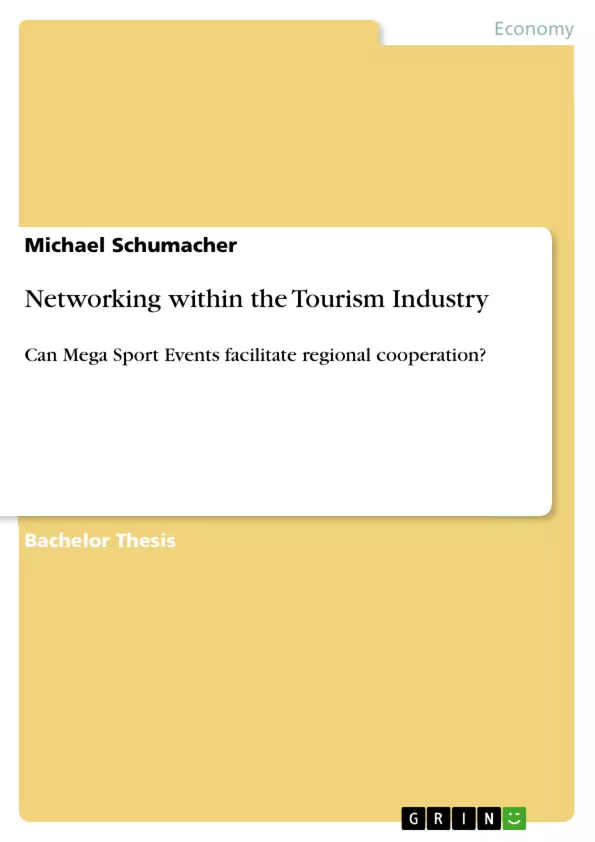As research around the impacts of Mega Sport Events on host cities and regions reached is peaking in the aftermath of the FIFA World Cup 2006, the UEFA European Football Championship 2008 and the Beijing Summer Games 2008 the topic of cooperation and networking has been widely neglected in regard to MSEs. With the focus on the tourism industry of hosting regions, this work tries to start to change this, as an exploratory approach towards finding out more about the interrelationship of those two topics in tourism. As both, MSEs and cooperation are gaining more and more interest within tourism research this should also be seen as an approach to combine both to motivate further research.
Methodologically this is realized by conducting expert interview with five industry experts with valuable experience in preparing, hosting and also benefiting from a Mega Sport Event. The expert interview, as the primary research part of this work is based on the cooperation concept of Axelrod’s game theory. This basis was used to design, conduct and analyze the primary research part of this thesis.
Essentially, the thesis should be interpreted as a scientific approach to present the combination of the topics of Mega Sport Events and cooperation in tourism.
Inhaltsverzeichnis (Table of Contents)
- ABSTRACT
- ACKNOWLEDGMENTS
- TABLE OF CONTENT
- LIST OF TABLES
- LIST OF APPENDICES
- LIST OF ABBREVIATIONS
- 1. INTRODUCTION
- 1.1. PROBLEM DEFINITION
- 1.2. KEY OBJECTIVES
- 1.3. STRUCTURE OF THIS WORK
- 2. LITERATURE REVIEW
- 2.1. IMPACTS OF MEGA SPORT EVENTS ON TOURISM
- 2.1.1. Economic Impacts of Mega Sport Events
- 2.1.2. Socio-Cultural Impacts of Mega Sport Events
- 2.1.3. Ecological Impacts of Mega Sport Events
- 2.1.4. Political Impacts of Mega Sport Events
- 2.1.5. Impacts of Mega Sport Events on Cooperation and Networking
- 2.2. COOPERATION AND NETWORKING IN THEORY
- 2.2.1. Definition of Cooperation
- 2.2.2. Definition of networks
- 2.2.3. Cooperation Theories
- 2.2.3.1. The Transaction-Cost-Theory
- 2.2.3.2. The Principal-Agent-Theory
- 2.2.3.3. The Game Theory
- 2.2.3.4. Resource Dependence Approach
- 2.2.3.5. Combinations
- 3. METHODOLOGY
- 3.1. QUALITATIVE RESEARCH
- 3.2. QUANTITATIVE RESEARCH
- 3.3. RESEARCH DESIGN
- 3.3.1. Explorative Research
- 3.3.2. Descriptive Research
- 3.3.3. Causal Research
- 3.3.4. The Research Design applied in this thesis
- 3.4. RESEARCH TECHNIQUES
- 3.4.1. Focus Groups
- 3.4.2. Unstructured or semi-structured observation
- 3.4.3. Depth Interviews
- 3.4.4. The Research Technique applied in this thesis
- 3.5. MAIL VS. PHONE VS. PERSONAL VS. WEB
- 3.6. QUESTIONNAIRE DESIGN
- 3.6.1. Target Respondents
- 3.6.2. Typology of the Questionnaire
- 3.6.3. Questionnaire Sections
- 3.6.4. Question Formulation
- 3.7. THE INTERVIEWEES
- 3.8. REALIZATION OF THE INTERVIEWS
- 4. PRIMARY RESEARCH RESULTS
- 4.1. QUESTION 1
- 4.2. QUESTION 2
- 4.3. QUESTION 3
- 4.4. QUESTION 4
- 4.5. QUESTION 5
- 4.6. QUESTION 6
- 4.7. QUESTION 7
- 4.8. QUESTION 8
- 4.9. QUESTION 9
- 4.10. QUESTION 10
Zielsetzung und Themenschwerpunkte (Objectives and Key Themes)
This bachelor thesis explores the potential of Mega Sport Events (MSEs) to facilitate regional cooperation within the tourism industry. The research focuses on understanding the interrelationship between MSEs and cooperation, aiming to provide a scientific foundation for further research in this emerging field. The study uses expert interviews with industry professionals to gather insights into the practical aspects of collaboration during and after major sporting events. The goal is to contribute to the ongoing discourse about the impacts of MSEs on host regions, specifically focusing on the tourism sector.
- The role of Mega Sport Events (MSEs) in fostering regional cooperation.
- The impact of MSEs on the tourism industry in host regions.
- The practical application of cooperation concepts in the context of MSEs.
- The potential benefits and challenges of collaboration for tourism stakeholders.
- The theoretical frameworks and game theory perspectives on cooperation.
Zusammenfassung der Kapitel (Chapter Summaries)
This work begins by establishing the context and research objectives for the study. It then delves into a comprehensive literature review exploring the multifaceted impacts of MSEs on tourism, including economic, socio-cultural, ecological, and political considerations. The chapter also examines theoretical frameworks related to cooperation and networking, specifically exploring the Transaction-Cost-Theory, the Principal-Agent-Theory, Game Theory, Resource Dependence Approach, and various combinations. The subsequent chapter outlines the methodology employed in this research, focusing on a qualitative approach through expert interviews. It elaborates on the research design, techniques, and specific questionnaire development and implementation details. The chapter concludes with a discussion of the chosen interviewees and the process of conducting the interviews. The final chapter presented in this preview delves into the primary research results, summarizing the key findings from each interview question.
Schlüsselwörter (Keywords)
This thesis revolves around the core concepts of Mega Sport Events (MSEs), regional cooperation, tourism, networking, game theory, expert interviews, and qualitative research. The study explores the complex interrelationships between these key areas, examining their practical applications and theoretical implications in the context of hosting and benefiting from MSEs. The study aims to contribute to the growing body of knowledge on the impacts of MSEs on tourism and regional development, providing valuable insights into the role of cooperation in optimizing these outcomes.
- 2.1. IMPACTS OF MEGA SPORT EVENTS ON TOURISM
- Quote paper
- Michael Schumacher (Author), 2008, Networking within the Tourism Industry, Munich, GRIN Verlag, https://www.grin.com/document/143096



